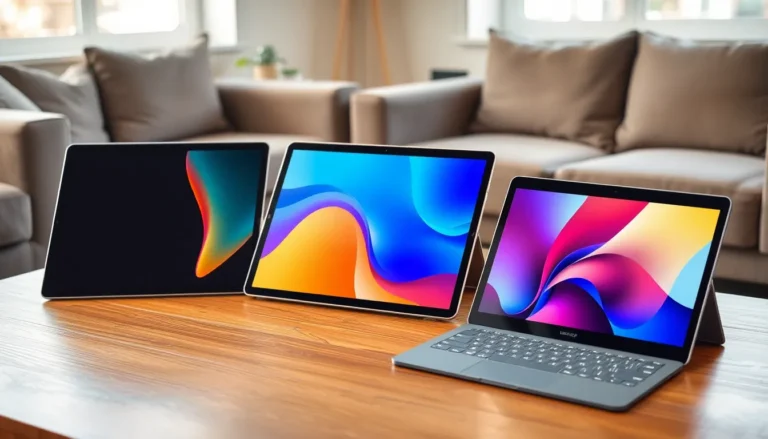In a world where bigger isn’t always better, compact computing devices are stealing the spotlight. These pocket-sized powerhouses pack a punch, proving that you don’t need a massive desk setup to get serious work done. Whether it’s a sleek laptop that fits in a backpack or a tiny desktop that doubles as a paperweight, these devices are game-changers for anyone who craves efficiency without the clutter.
Table of Contents
ToggleOverview of Compact Computing Devices
Compact computing devices have gained significant popularity in recent years due to their ability to blend performance with portability. These devices range from ultra-slim laptops to powerful mini PCs, catering to various users’ needs. Sleek laptops provide robust functionality without the weight, making them ideal for students and professionals on the go. Tiny desktops offer powerful processing capabilities while consuming minimal space, fitting comfortably into any workspace.
Companies increasingly design these devices to maximize efficiency without sacrificing power. Performance specifications often include advanced processors, ample storage options, and vibrant displays. Many compact devices utilize energy-efficient components to extend battery life during mobile use, ensuring users stay productive throughout the day.
Various applications benefit from these devices. Gamers appreciate compact systems equipped with high-performance graphics cards, while creative professionals find versatility in portable workstations. In the business sector, compact computing devices streamline work processes, enabling seamless collaboration and communication.
Affordability varies across the range, making compact computing options accessible to a wider audience. Budget-friendly laptops and desktops provide essential features, while premium models deliver cutting-edge technology. The growing market for 2-in-1 devices showcases the desire for multifunctionality, allowing users to transition between tablet and laptop modes.
Compact computing devices are reshaping the landscape of technology. Their combination of portability and efficiency is poised to redefine work and leisure environments, making them integral to modern lifestyles.
Types of Compact Computing Devices

Compact computing devices come in various forms, with each type designed to cater to specific user needs. Here are some of the most common types.
Laptops and Ultrabooks
Laptops are versatile machines that allow for easy portability and functionality. They come in various sizes and specifications to suit different users. Ultrabooks represent a thinner, lightweight evolution of laptops, often featuring advanced processors and solid-state drives for enhanced speed. Both offer excellent battery life, making them ideal for individuals who work remotely or travel frequently. High-resolution displays provide vibrant visuals, increasing productivity for tasks like graphic design and video editing.
Tablets and 2-in-1 Devices
Tablets offer a touch-based interface that enhances user experience for browsing, reading, and entertainment. Many tablets support styluses, catering to creative professionals and students. 2-in-1 devices combine the functionality of a tablet with that of a laptop, featuring detachable keyboards or flexible hinges. This versatility allows users to switch quickly between work and play. Both options typically emphasize lightweight designs and exceptional battery life, ensuring uninterrupted use throughout the day.
Mini PCs and Microcomputers
Mini PCs pack powerful components into compact cases, perfect for users requiring high performance in limited space. Designed for gaming, media consumption, and office tasks, these devices afford users flexibility without sacrificing power. Microcomputers, even smaller in size, often serve specialized functions like media servers or digital signage. Options like these enable users to save desk space while maintaining strong processing capabilities for daily activities. Many models offer energy-efficient designs to reduce environmental impact.
Advantages of Compact Computing Devices
Compact computing devices offer distinct benefits that enhance user experience in various environments. Their design prioritizes user flexibility while maintaining functionality.
Portability and Convenience
Compact devices excel in portability and convenience. Weighing less than traditional laptops, they easily fit into bags, making them ideal for travel. Users appreciate their lightweight nature, allowing for comfortable use in various settings. Many manufacturers design these devices with user mobility in mind. Features like long battery life support extended use without requiring constant charging. Additionally, they often include robust connectivity options, enabling seamless access to networks and peripherals. Quick setups reduce transition times between locations, making them perfect for remote work scenarios. Overall, the combination of light weight and easy handling boosts productivity on the go.
Performance Efficiency
Performance efficiency characterizes compact computing devices, outperforming expectations for their size. Advanced processors and optimized software contribute to rapid operations, ensuring users experience minimal lag. Many compact devices incorporate solid-state drives to enhance data access speeds. Users benefit from vibrant displays that deliver excellent visual quality. Energy-efficient components extend device lifespan, reducing the need for frequent replacements. Compact gaming laptops and portable workstations demonstrate that high-performance tasks are achievable without bulky designs. Graphic designers and gamers find that these devices deliver remarkable power in small packages. Overall, users experience effective performance without sacrificing essential functions.
Challenges in Compact Computing Devices
Compact computing devices face several challenges that can impact performance and user experience.
Heat Management
Heat management poses a significant challenge for compact computing devices. High-performance components generate heat, and limited space restricts proper ventilation. Cooling solutions must be efficient, often utilizing advanced thermal management technologies. Some manufacturers integrate heat pipes or specialized fans to manage temperatures effectively. Users will notice that excessive heat can lead to throttled performance and potential hardware damage. Consequently, maintaining optimal operating temperatures is crucial for reliability.
Upgrade Limitations
Upgrade limitations present another obstacle for compact computing devices. Many of these devices feature soldered components, making upgrades difficult or impossible. Users may find that storage and memory capacities are fixed, leading to potential performance issues over time. Some models, however, allow for limited upgrades, usually involving additional storage options or external peripherals. As technology evolves, having the ability to upgrade components remains vital for maximizing device longevity and performance. Ultimately, understanding these limitations can help consumers make informed decisions.
Future of Compact Computing Devices
Emerging trends indicate a bright future for compact computing devices, driven by technological advancements in microprocessors and AI capabilities. Innovations aim to enhance performance while reducing footprint, appealing to users seeking efficiency in smaller formats.
Increased integration of 5G technology enriches connectivity options, allowing users to access high-speed internet wherever they go. High-resolution displays continue to evolve, providing immersive viewing experiences even in compact designs.
Renewable energy sources and energy-efficient components will become essential as environmental awareness grows. Devices that utilize solar cells or advanced battery technologies support longer usage times and reduced environmental impact.
Enhancements in cooling solutions address heat management challenges, leading to better performance without sacrificing device size. Companies are investing in advanced materials that improve thermal conductivity, ensuring optimal operation in various conditions.
Upgradability remains a concern, yet solutions such as modular designs emerge, allowing users to customize and enhance their devices. New manufacturers are pushing the boundaries of compact design while offering robust functionality, making these upgrades feasible.
The rise of augmented and virtual reality applications highlights how compact computing can redefine user interactions. As these technologies advance, users will benefit from high-performance devices that deliver powerful capabilities in smaller packages.
Overall, compact computing devices are poised to revolutionize productivity, entertainment, and communication. Such trends indicate a shift toward more dynamic and innovative solutions, catering to diverse user needs as technology continues to evolve.
Compact computing devices are undeniably shaping the future of technology. Their ability to deliver high performance in a small form factor meets the demands of today’s mobile lifestyle. As users seek efficiency without compromising on capabilities, these devices offer a compelling solution.
The ongoing advancements in technology promise even greater improvements in performance and usability. Innovations in thermal management and energy efficiency will address existing challenges, making compact devices more reliable. With the rise of multifunctional devices and enhanced connectivity options, the landscape of computing is set for a significant transformation.
As compact computing continues to evolve, it will play a crucial role in enhancing productivity and enriching user experiences across various fields. Embracing these devices means embracing the future of technology.









